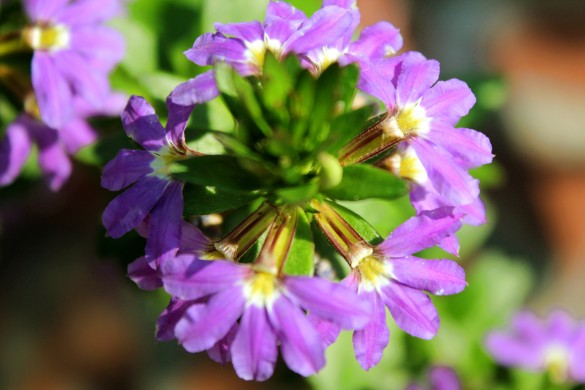Written by Matthew Patterson, Visitor Services Associate
 Scaevola is a genus of flowering plants consisting of more than 130 tropical species, with the center of diversity being Australia and Polynesia, including Hawaii.
Scaevola is a genus of flowering plants consisting of more than 130 tropical species, with the center of diversity being Australia and Polynesia, including Hawaii.
The Hawaiian Islands are home to ten Scaevola species, nine of which are unique to their location. Eight of the indigenous species are the result of a single colonization event. Scaevola glabra and scaevola taccada arrived separately to produce a total of three colonizations of Hawaii by Scaevola.
 Common names for Scaevola include fan-flowers, half-flowers, and naupaka, the plant’s Hawaiian name. Several legends exist to explain the formation of the naupaka’s unique half flower shape. One version tells the story of a woman who tears the flower in half after a quarrel with her lover. In return the angry Gods turned all naupaka flowers into half flowers and the two lovers remained separated while the man was destined to search in vain for another whole flower.
Common names for Scaevola include fan-flowers, half-flowers, and naupaka, the plant’s Hawaiian name. Several legends exist to explain the formation of the naupaka’s unique half flower shape. One version tells the story of a woman who tears the flower in half after a quarrel with her lover. In return the angry Gods turned all naupaka flowers into half flowers and the two lovers remained separated while the man was destined to search in vain for another whole flower.
Another legend might serve to explain the flower’s proper name. In the 5th century BC a young Roman named Gaius Mucius was captured while attempting to assassinate a rival king. To prove his bravery and his willingness to die for his country, Gaius Mucius placed his hand in a camp fire. For this he and his descendants received the name Scaevola which translates from Latin to mean “left-handed”, a fitting name for a flower that is missing its right half.
Scaevola makes a unique and beautiful addition to the gardens of the Cummer Museum and is worth seeking out the next time you visit.


